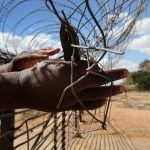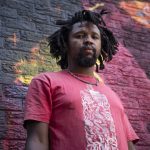From the Archive | Freedom Dreams
Historian Robin DG Kelley envisions Freedom Space, a liberated zone where people play, debate and dream. Limited only by our imaginations, it represents a new, cooperative world.
Author:
11 April 2019

In this seminal work, which charts the work of major black thinkers, Robin DG Kelley wonders how we produce a vision that enables us to see beyond our immediate ordeals and transcend bitterness and cynicism to embrace love, hope and an all-encompassing dream of freedom.
This is an edited excerpt from Robin DG Kelley’s Freedom Dreams: The Black Radical Imagination (2002).
When I first conceived of this book, I imagined ending on a dream of my own. In fact, on 11 September 2001, the epilogue was already written and my dream was poised for action. It was a long dream to be sure, a fantastic, futuristic tale of a group of “Maroon poets” who transform a local struggle over police brutality into a full-fledged revolution rooted in love, creativity and cooperation over the course of 700 years. In my dream, it took 30 generations of poets, surviving and creating in the “liberated zones” of North America’s ghettos, to build a cooperative world without wages or money.
After September 11, however, my original epilogue/dream felt uncomfortably apocalyptic. The immediate question of “where do we go from here” invaded my daydreams and dominated my nocturnal adventures, along with the constant stench of burning metal, concrete and Lord knows what else enveloping our neighbourhood, and the horrendous image of bombs raining down on terrified Afghans. Where are we heading? How do we begin to dream ourselves out of this dark place of death and destruction and war, from this suffocating place where anyone who is not down with the war plan could be labelled a traitor? It’s very hard to imagine a visionary social movement when officials can openly advocate the racial profiling of “Arab-looking” people with hardly a voice of dissent, or when laws are passed that ease wiretapping of private citizens and allow officials to detain immigrants without charge.
Related article:
So in the spirit of all the freedom dreamers who make up this book, I would like to close with a few brief reflections on where we might go from here. Strangely, I’ve been thinking particularly about ways to rebuild the smouldering, desolate landfill that once hosted these two powerful symbols of global capital and consumer culture. What shall we build on the ashes of a nightmare? We don’t need another hall of finance, wealth and exclusivity; no more symbols of class, power, and privilege. We don’t need another gargantuan modern-day mill where some working people slave over mops and vacuum cleaners in the wee hours of the morning, and others over computers and fax machines way past sundown. Yes, jobs are valuable and necessary in a world where everything – even food, shelter and clothing – is a commodity. But now is the time to think like poets, to envision and make visible a new society, a peaceful, cooperative, loving world without poverty and oppression, limited only by our imaginations.
First, let’s declare the land international territory to be governed by a joint council made up of representatives from the United Nations and First Nations (ie, Native Americans with roots in the region). The space should no longer be considered to lie within the jurisdiction of New York City, New York State or the United States. The land belongs to the world and thus should not be privatised.
Related article:
Second, the international governing council should pull together a group of artists from all over the world, women and men, young and old, representing all continents, who will collectively transform the space into a giant park that extends from the existing Hudson River and Battery parks along the waterfront. Although the word freedom in the United States is fraught with patriotic, jingoistic baggage, I would nevertheless call it “Freedom Space” and position signs throughout the park with the word freedom in every known language. This would not be just any park. Imagine a space filled with odd, beautiful play structures intended to force people to engage each other. (I can’t help thinking of the dynamic young artist Ellen Gallagher, who constructed a beautiful jungle gym as an installation for her 2001 travelling show “Preserve”. As she explained to me recently, the jungle gym was originally designed in post-Nazi Germany as a
way to enable free, unstructured, democratic play.)
I can envision a section composed of large round picnic tables, a great lawn for playing and dreaming, sandboxes for kids of all ages, works of art that we can engage organically rather than as distant objects … works of art that might spur us to talk to each other. An amphitheater and/or band shell will occupy opposite corners of the space. Music, theatre, comedy, all manner of performance across genres, nationalities and languages will take place every day when weather permits. All performances are free.
Related article:
Indeed, everything should be free, including food and drink. And how about a row of nice, airy bungalows with beds and showers for the homeless? We can pay for all this by requiring all nations affiliated with the UN to contribute annually at least one percent of their military budgets to maintaining and developing Freedom Space. Whatever surplus is left over should be earmarked either to promote global peace or pay reparations to war victims. (An even more radical idea might be to create a sliding scale whereby each nation would have to pay according to the damage its armed forces have inflicted on the rest of the world during the past century! But such a formula would prove much too difficult to calculate.)
I won’t propose much more since the design and realisation of such a space ought to be the product of a collective imagination shaped and reshaped by the very process of turning rubble and memory into the seeds of a new society. Of course, I take it for granted that creating a space such as this – whether it is on a small plot of lower Manhattan, or the larger plot we call the United States, or the huge rock we call earth – will never happen without a struggle. Struggle is par for the course when our dreams go into action. But unless we have the space to imagine and a vision of what it means fully to realise our humanity, all the protests and demonstrations in the world won’t bring about our liberation.



